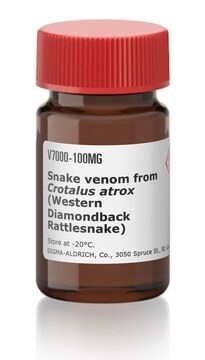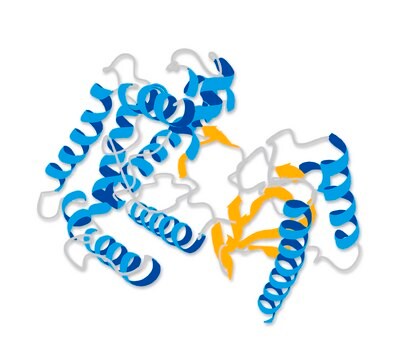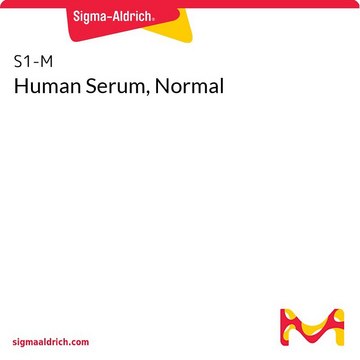233552-M
Czynnik jadu kobry, Naja naja kaouthia
Cobra Venom Factor, Naja naja kaouthia, is a native cobra venom factor. Glycoprotein composed of three non-identical disulfide-bonded subunits of 68, 48, and 30 kDa.
Synonim(y):
Białko antykomplementarne jadu kobry
Zaloguj sięWyświetlanie cen organizacyjnych i kontraktowych
About This Item
Kod UNSPSC:
12352202
Polecane produkty
Poziom jakości
Próba
≥95% (SDS-PAGE)
Formularz
liquid
aktywność właściwa
≥250 units/mL
producent / nazwa handlowa
Calbiochem®
warunki przechowywania
OK to freeze
avoid repeated freeze/thaw cycles
obecność zanieczyszczeń
Phospholipase, none detected
temp. przechowywania
−70°C
Opis ogólny
Natywny czynnik jadu kobry z Naja naja kaouthia. Glikoproteina złożona z trzech nieidentycznych podjednostek związanych dwusiarczkiem o masie cząsteczkowej 68 kDa (α), 48 kDa (β) i 30 kDa (γ). Czynnik jadu kobry (CVF) jest strukturalnym i funkcjonalnym analogiem kobry, a także ssaków C3. Tak więc, w obecności czynnika B, czynnika D i Mg2+, CVF może tworzyć stabilny kompleks CVF,Bb, który jest enzymem konwertazy C3/C5; jednak kompleks CVF,Bb nie jest podatny na regulację przez czynniki H i I. Cztery do sześciu µg oczyszczonego CVF jest równe 1,0 jednostce aktywności funkcjonalnej mierzonej metodą Cochrane'a i wsp.
Ostrzeżenie
Toksyczność: Szkodliwy (C)
Inne uwagi
Bogers, W.M., et al. 1993. Eur. J. Immunol.23, 433.
Fritzinger, D.C., et al. 1992. J. Immunol. 149, 3554.
Muller, B. i Muller-Ruchholtz, W. 1987. Leuk. Res.11, 461.
Vogel, C.W. and Muller-Eberhard, H.J. 1984. J. Immunol. Methods73, 203.
Cochrane, C.G., et al. 1970. J. Immunol. 105, 55.
Ballows, M. and Cochrane, C.G. 1969. J. Immunol.103, 944.
Fritzinger, D.C., et al. 1992. J. Immunol. 149, 3554.
Muller, B. i Muller-Ruchholtz, W. 1987. Leuk. Res.11, 461.
Vogel, C.W. and Muller-Eberhard, H.J. 1984. J. Immunol. Methods73, 203.
Cochrane, C.G., et al. 1970. J. Immunol. 105, 55.
Ballows, M. and Cochrane, C.G. 1969. J. Immunol.103, 944.
Informacje prawne
Niedostępne w sprzedaży poza Stanami Zjednoczonymi.
CALBIOCHEM is a registered trademark of Merck KGaA, Darmstadt, Germany
Ta strona może zawierać tekst przetłumaczony maszynowo.
Kod klasy składowania
12 - Non Combustible Liquids
Klasa zagrożenia wodnego (WGK)
WGK 2
Temperatura zapłonu (°F)
Not applicable
Temperatura zapłonu (°C)
Not applicable
Certyfikaty analizy (CoA)
Poszukaj Certyfikaty analizy (CoA), wpisując numer partii/serii produktów. Numery serii i partii można znaleźć na etykiecie produktu po słowach „seria” lub „partia”.
Masz już ten produkt?
Dokumenty związane z niedawno zakupionymi produktami zostały zamieszczone w Bibliotece dokumentów.
Nasz zespół naukowców ma doświadczenie we wszystkich obszarach badań, w tym w naukach przyrodniczych, materiałoznawstwie, syntezie chemicznej, chromatografii, analityce i wielu innych dziedzinach.
Skontaktuj się z zespołem ds. pomocy technicznej








